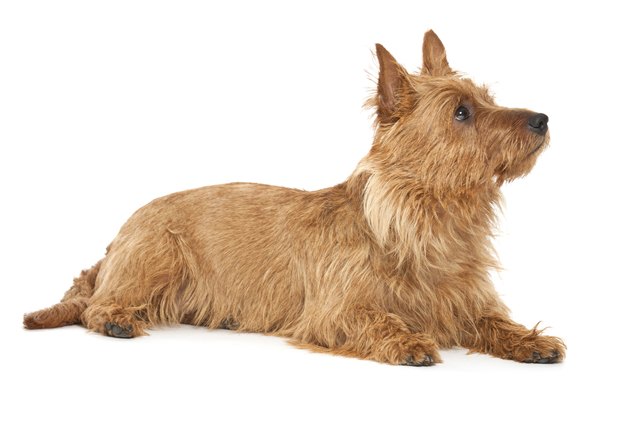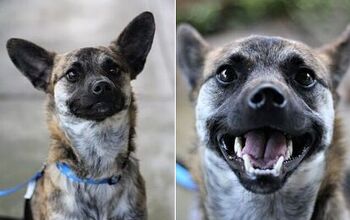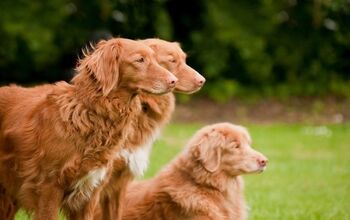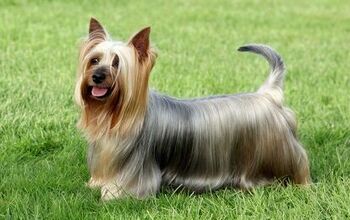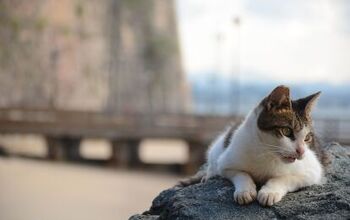Australian Terrier


About Australian Terrier
This little feller from the land Down Under is a happy dog that loves everyone. Fond of children, the elderly, and the and generally a laid-back dog, the Australian Terrier makes the ideal companion for a variety of households. From its origins as a vermin catcher, the Australian Terrier is the smallest of working terriers. But don’t let its size fool you – this breed is full of pep and energy. That means it needs a good amount of exercise every day, so long walks or an unleashed run in a safe area are essential.
One of the most extraordinary traits of this petite pooch must be its keen awareness of its owner’s moods. These dogs grow very close to their family members and the bond they create is so strong that they will follow your every step. Often, this also means adjusting the pace to follow your emotional state- making this adorable dog a true companion in every sense of the word.
There is so much to love about the Australian Terrier. It fits in with families and likes being outdoors. Just a few of its endearing traits include that it is fairly quiet, fun, energetic, tough, eager to please, and adventurous. If you plan on leaving it in the backyard, be warned – the Australian Terrier likes to dig up a storm. Does the Australian Terrier sound like a fit for you? Read on and find out.
Fond of children, the elderly, and the handicapped, the Australian Terrier makes the ideal companion for a variety of households.
Bred to be both a hard worker and a companion, the Australian Terrier (also affectionately called the Aussie) originated in Tasmania in the early 19th century. Source indicate that the ancestor of this charming breed was the common rough-coated terrier that was brought over to the continent from Britain. These terriers are believed to have been cross-bred with a number of other British terrier breeds. The purpose was to develop a fast, tough and weatherproof dog to use for Australians who worked on farms. The Australian Terrier’s job was to hunt rodents and snakes, as well as to tend sheep and alert farmers to the presence of strangers.
When people first started developing the breed in the 1820s, they called these feisty fellers Rough-Coated Terriers. The first representatives of this new breed were shown in 1868 in Melbourne, and the breed got its official name in 1897. Another interesting fact is that the Australian Terrier is the first dog breed both to be created and recognized in Australia.
The Australian Terrier can trace its roots back to a number of different dog breeds. These include Dandie Dinmont, Skye, Yorkshire, and Black-and-Tan Terriers (known now as Manchester Terriers). It’s also suspected that Irish and Cairn Terrier are mixed in as well. The reasoning behind the crossbreeding was to promote specific desired traits to produce a sturdy, weatherproof and fearless little dog that would not only take care of vermin such as rodents and snakes, but also to tend flocks, guard the homestead and be a wonderful family companion.
The Australian Terrier is recognized by all major canine clubs all over the world. The American Kennel Club enlisted these dogs as an official breed in 1960, and the UK Kennel Club did the same almost 3 decades earlier in 1933.
The Australian Terrier isn’t a picky eater – it likes to chow down on anything you feed it. But, to be happy and healthy, every dog needs a well-balanced, healthy diet. A proper diet includes all-important nutrients, minerals, vitamins, fats, carbohydrates, proteins, and a source of fresh, clean water. The majority of veterinarians recommend high-quality dry food for dogs as the best option. Kibble is nutritionally complete, convenient and readily available, and most dogs love eating it! However, you’ll have to pay attention to your choice of dry food. Only premium, high-quality brands are a good choice, and those blend that suit your pet’s age (puppy, adult, senior) and their size and activity level (kibble formula for small breeds).
Be sure to feed your dog according to feeding guide recommendations – you don’t want to overfeed your Aussie. As a small breed dog, it is prone to obesity and even moderate weight gain over their usual size can put a stress on their petite frame. Excess weight also leads to a host of health issues, and can significantly lower your dog’s quality of life. Healthy diet and exercise are the best prevention!
Just a few of its endearing traits include that it is fairly quiet, fun, energetic, tough, eager to please, and adventurous.
When you bring home an Australian Terrier, you need to set up leadership roles right away. Only then will you be successful in your training endeavors. This breed can be independent and will try to take on the leader role, but stand your ground. Overall, it’s an eager-to-please breed and this dog will want to win your praise and attention. To establish your leadership role, start training early and exude an air of confidence. When your Aussie completes a task to your satisfaction, give positive reinforcement and rewards – it makes training go a lot smoother.
This is a terrier, so expect barking and a dog that lives for the chase. The Aussie is a good listener when it’s just you and the dog, but if it goes after another animal, it won’t stop and listen to your commands. It’s better to be safe than sorry, so keep your Australian Terrier on a leash or in a fenced-in area.
When it comes to training the Australian Terrier, begin with your basic stuff. Housebreaking, leash training, and simple commands such as sit, stay and drop it are a good place to start. These are intelligent dogs so you won’t have issue teaching them as long as you have the right approach. In fact, their smarts might drive them to progress further than basic obedience- the Australian Terrier can be quite a superstar in dog sports such as agility.
In addition to training, socialization will be of utmost importance. Those terrier genes almost guarantee you that your new fur baby will love nothing more than to bother animals smaller than him. Whether it’s just a chase or more, timely socialization could help curb their high prey drive, if only to make them behave tolerably with their furry roommates.
Once an Australian Terrier hits maturity, it will stand about 10 to 11 inches and weight anywhere from 14 to 16 pounds.
Happy go lucky and eager to please, the Australian Terrier is full of personality. As a terrier, the Aussie likes to bark, but less so than its counterparts. And don’t let its size fool you – even though this is a small dog, the Aussie makes an excellent watch dog.
Intelligent and always on the go, Australian Terriers love to dig. If you leave them in the backyard unsupervised, don’t be surprise to come back to an unearthed garden. Because of its background of herding cattle and hunting vermin, this breed is fearless and has endless amounts of energy. Even though it isn’t used for the same tasks these days, the instincts are still the same. With its independent streak, this breed may try to dominate small children. Early training should prevent this bad habit.
When it comes to meeting new people, the Australian Terrier can be a bit stand-offish. Don’t worry – that will soon wear off and your Aussie will make friends after a pat on the head and a scratch behind the ear. If you have other pets in the household, this breed will live in harmony with them. But like other terrier breeds, there may be some tension between dogs of the same sex.
A hardy and healthy breed, the Australian Terrier shouldn’t run up your vet bills. However, so health concerns related to this breed include allergies, arthritis, cataracts, diabetes, cancer, Legg-Calve-Perthes disease, patellar luxation and thyroid issues.
The Australian Terrier has an average lifespan of 12 to 15 years.
For a small dog, the Australian Terriers sure has a large amount of energy. That’s why it needs lots of regular exercise. Because this breed likes to hunt and herd, it helps to have a yard where it can chase toys and birds. If you have an apartment, daily walks or trips to the park are a must.
A dog for a range of lifestyles, the Aussie fits into any household. This breed loves children, so use them to exercise Australian Terrier. Games, jogging, hikes and other outdoor pastimes will keep the Australian Terrier amused. Also needed is mental stimulation – interactions with new people, animals and experiences are good for your Australian Terrier’s mental health.
Intelligent and always on the go, Australian Terriers love to dig.
The American Kennel Association says this about the breed: “They have a keen and alert expression and confident spirit. They are versatile in their work and living situations, making suitable companions in most environments.” The AKC first recognized this breed in 1960.
The thick, course outer coat of the Australian Terrier covers a soft undercoat. All along the dog’s dog, hair is about two inches long, but it does grow longer on the head and chest. When it comes to coat color, there’s not much variety: blue and tan (tan body with a blue saddle), sandy, and red.
This breed only sheds a minimal amount throughout the year. To keep loose hair at bay (as well as tangles and mats), brush the Aussie’s coat several times a week. Don’t subject the Australian to too many baths, as it will soften its coat. You should bathe them once every 3 or 4 months, if they’re your pet and not a show dog.
Australian Terriers usually have relatively small litters, with the average being 2 to 4 puppies. This is a small breed to begin with, so be extra careful when stepping around them. Additionally, if there are children in the household, don’t leave them alone to play with puppies. They could unintentionally hurt them, as they’re very small and fragile in their young age.
Be sure to give your Australian Terrier puppy enough exercise to drain some of that abundant energy. Naturally, you should also start with training and socialization as soon as possible- it will ensure your mischievous terrier puppy grows up to be a well-behaved, friendly dog.
Photo credit: Andreas Gradin/Shutterstock

Amy Tokic, Editor of PetGuide.com, is a passionate animal lover and proud pet parent of Oscar, a Shih Tzu/Chihuahua cross, and Zed, a Japanese Chin. Her love of animals began in kindergarten, when she brought her stuffed dog Snoopy into class with her every day. Now, she writes about her adventures in pet ownership and tirelessly researches products, news and health related issues she can share with other animal enthusiasts. In her free time, Amy loves perusing used book and record stores, obsessing over the latest pet products available and chasing squirrels with wild abandon (a habit attributed to spending too much time with her pooches).
More by Amy Tokic



